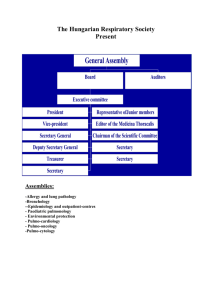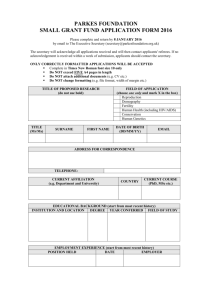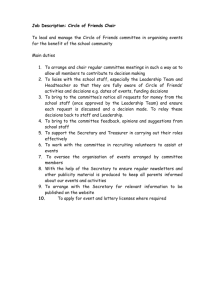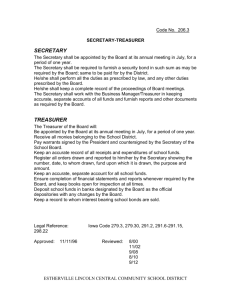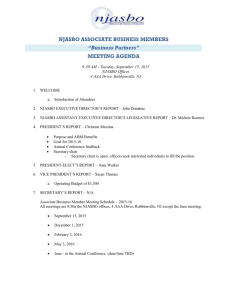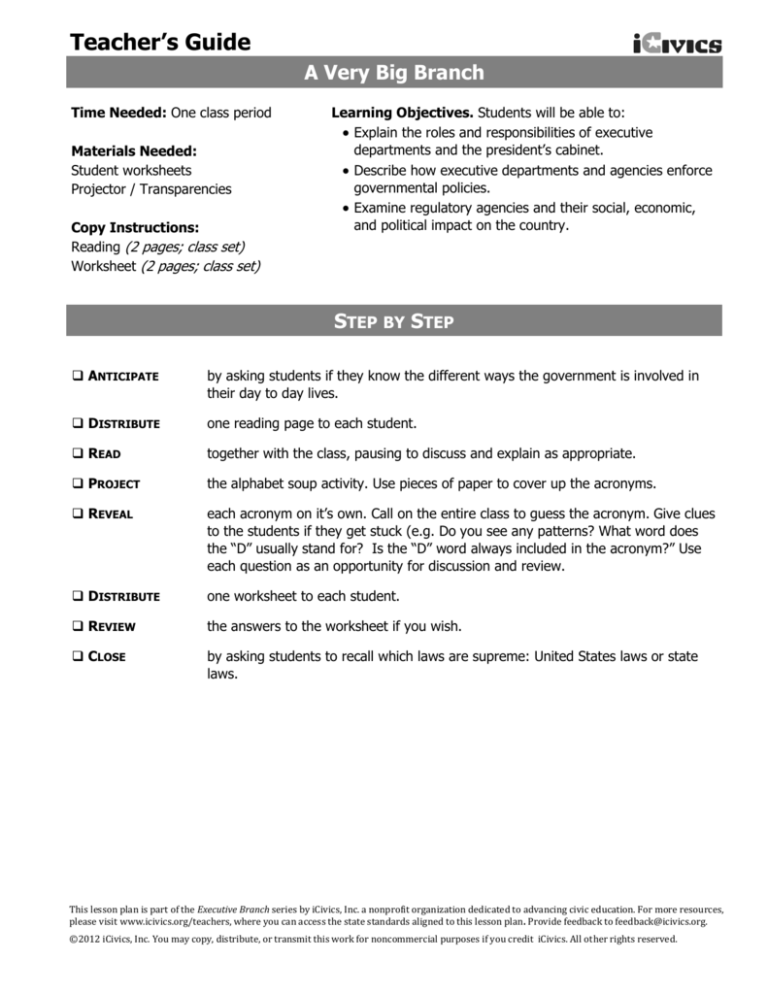
Teacher’s Guide
A Very Big Branch
Time Needed: One class period
Materials Needed:
Student worksheets
Projector / Transparencies
Copy Instructions:
Reading (2 pages; class set)
Worksheet (2 pages; class set)
Learning Objectives. Students will be able to:
Explain the roles and responsibilities of executive
departments and the president’s cabinet.
Describe how executive departments and agencies enforce
governmental policies.
Examine regulatory agencies and their social, economic,
and political impact on the country.
STEP BY STEP
ANTICIPATE
by asking students if they know the different ways the government is involved in
their day to day lives.
DISTRIBUTE
one reading page to each student.
READ
together with the class, pausing to discuss and explain as appropriate.
PROJECT
the alphabet soup activity. Use pieces of paper to cover up the acronyms.
REVEAL
each acronym on it’s own. Call on the entire class to guess the acronym. Give clues
to the students if they get stuck (e.g. Do you see any patterns? What word does
the “D” usually stand for? Is the “D” word always included in the acronym?” Use
each question as an opportunity for discussion and review.
DISTRIBUTE
one worksheet to each student.
REVIEW
the answers to the worksheet if you wish.
CLOSE
by asking students to recall which laws are supreme: United States laws or state
laws.
This lesson plan is part of the Executive Branch series by iCivics, Inc. a nonprofit organization dedicated to advancing civic education. For more resources,
please visit www.icivics.org/teachers, where you can access the state standards aligned to this lesson plan. Provide feedback to feedback@icivics.org.
©2012 iCivics, Inc. You may copy, distribute, or transmit this work for noncommercial purposes if you credit iCivics. All other rights reserved.
The Executive Branch
A Very Big Branch
Name:
We’ve Got a Job to Do
President
The job of the executive branch is to carry out the laws that the
legislative branch passes. When you think of the executive branch,
you probably think of the president. But the president is only the
head of the executive branch. He is like the tip of the iceberg:
underneath, there is a giant organization with lots of people doing
many different jobs. In fact, the executive branch is the largest
branch of our government!
Executive
Departments
& Agencies
Help From Many
Most of the executive branch is made up of departments and independent
agencies. Departments are the main organizations in the executive branch.
There are 15 departments, and each one focuses on a specific type of activity
such as education, transportation, defense, or energy. Each department has
smaller agencies that do specific jobs. For example, the Department of Justice
(DOJ) operates our justice system and works to prevent crime. Two agencies
inside the DOJ are the Federal Bureau of Investigation (FBI) and the Drug
Enforcement Administration (DEA). The FBI investigates certain kinds of crimes,
while the DEA deals with crime related to drugs and controlled substances.
There are 52 agencies and
offices within the DOJ.
The president appoints a secretary to lead each department.
(But the head of the Department of Justice is called the Attorney
General (AG)). These department heads make up the president’s
cabinet, which acts as a group of advisors to the president. They
help the president make important decisions about how laws
should be carried out.
President Obama meets with his cabinet.
Independent agencies are government organizations that
also focus on specific issues, but they are different from
departments because they are independent of the
president’s control. Instead, these agencies are controlled by
a board or commission. The president can appoint someone
to the board or commission but cannot remove them.
Carrying Out Laws: Enforcement
What does it mean to “carry out” a law? That depends on the kind of law that
needs to be carried out. Some laws make things illegal and describe
consequences for those who do those things. Executive agencies enforce the
law when someone isn’t following it. There are several things an agency can
do to enforce a law:
The U.S. Marshals Service is the
oldest federal law enforcement
agency. Marshals provide court
security, hunt fugitives, and
offer witness protection.
Educate the public about new laws
Monitor the public to make sure laws are being followed
Catch individuals or organizations not following the law
Take the offenders to court
Follow any other enforcement procedures the agency may have
Reading p.1
A Very Big Branch
Name:
Carrying Out Laws: Regulations
Other laws are just instructions about something that must be done, such as
installing new security procedures at the nation’s airports. A law like this will
not include every last detail about how it should be carried out. Instead, the
law will authorize the executive branch to decide these details. The rules the
executive branch makes about how the law will be carried out are called
regulations. Regulations have power similar to laws. Some regulations make
activity illegal, and others give instructions for how something must be done.
The Department of Agriculture
inspects more than eight
million birds every year.
Agencies Enforce and Regulate
Most departments and agencies both enforce laws and make
regulations. For example, the Environmental Protection Agency
(EPA) is an independent agency whose goal is to protect the
environment and human health. It carries out laws passed by
Congress, such as the Clean Air Act that is designed to limit air
pollution. The Clean Air Act authorizes the EPA to set limits on
how much pollution can be put into the air. To do this, the EPA
issues regulations that say exactly how much pollution vehicles,
factories, and other sources can put into the air. The EPA then
works to enforce these regulations. Violating them can result in
penalties.
Maintaining Order and Safety
We depend on many parts of the executive branch to keep us safe and to
keep order. For example, the Department of Homeland Security (DHS) is
responsible for protecting the United States against all kinds of threats. It
includes agencies that deal with terrorism, natural disasters, and border
protection. It even includes the Secret Service, whose agents protect the
president! Inside the DHS, the Federal Emergency Management Agency
(FEMA) responds to natural disasters to help people get the help they
need in an orderly way. The Coast Guard, also part of DHS, patrols our
nation’s coastlines to watch for threats and help boats in distress.
The headquarters of the DoD
is located at the Pentagon.
The ever-present Secret Service
has the president’s back.
The Department of Defense (DoD) is the biggest department. It includes all
the military departments such as the Army, Navy, and Air Force, as well as
many other agencies. Together, all the parts of the Department of Defense
work together to make sure our armed forces are prepared to protect our
nation’s security.
Busy, Busy
Remember that most of the day-to-day activity in the executive branch
involves ordinary people doing the work that needs to be done: an FBI
agent conducts an investigation, a soldier participates in training exercises,
or a worker monitors a nuclear reactor at an energy plant. The executive
branch needs people to answer phones, program computers, file papers,
do scientific research, process mail, fly airplanes, and clean bathrooms. In
fact, the federal government is the nation’s largest employer, and most of
those jobs are in the executive branch.
A U.S. Postal Service employee
works hard to deliver your mail.
Reading p.2
A Very Big Branch
Alphabet Soup
You’ve ran across some acronyms in the reading.
See if you can remember these:
DoJ
DEA
EPA
FBI
AG
DHS
FEMA
DoD
Did you notice any patterns? See if you can
figure out the acronyms for these agencies:
DoE
HHS
VA
DoEd
HUD
CIA
Activity Projection Master
A Very Big Branch
Name:
A. Cabinet Departments. Use the word bank to fill in the missing words from the graphic organizer:
Attorney
military
armed
basic needs
homes
money
fuel
college
highway
public lands
wages
countries
terrorists
farmers
trade
court
The President’s Cabinet
Executive Branch Departments
SECRETARY OF STATE
Department of State
SECRETARY OF THE TREASURY
SECRETARY OF DEFENSE
Department of the Treasury
Department of Defense
Manages our relationships
with foreign ______________
Collects taxes, prints ________,
deals with the nation’s finances
Manages the ___________
forces and wars overseas
_____________ GENERAL
SECRETARY OF THE INTERIOR
SECRETARY OF AGRICULTURE
Department of Justice
Department of the Interior
Department of Agriculture
Fights crime and runs the
federal __________ system
Manages and protects the
nation’s _______________
Works with ______________
and regulates farm products
SECRETARY OF COMMERCE
SECRETARY OF LABOR
SECRETARY OF TRANSPORTATION
Department of Commerce
Department of Labor
Department of Transportation
Supervises __________ and
promotes U.S. businesses
Helps workers get fair ______
and working conditions
Oversees ____________ safety
and air, rail, and sea travel
SECRETARY OF ENERGY
SECRETARY OF EDUCATION
Department of Energy
SECRETARY OF VETERANS AFFAIRS
Department of Education
Department of Veterans Affairs
Researches sources of ______
and electricity for the nation
Gives money for K-12 schools
and student _________ loans
Provides services for people who
served in the _____________
SEC. OF HEALTH & HUMAN SERVICES
SEC. OF HOMELAND SECURITY
SEC. OF HOUSING & URBAN DEVELOPMENT
Dep’t of Health & Human Services
Gives services for Americans’
health and _______________
Dep’t of Homeland Security
Dep’t of Housing & Urban Development
Protects against ___________
and other threats
Creates strong communities
and affordable __________
B. Who Said That? Identify which secretary might give the following advice or information:
1) “Mr. President, we need to invest in more solar electricity.”
Sec. of ___________________
2) “Mr. President, we saw a decrease in highway deaths this year.”
Sec. of ___________________
3) “Mr. President, agents intercepted a terrorist threat this morning.”
Sec. of ___________________
4) “Mr. President, it’s time to take the penny out of circulation.”
Sec. of ___________________
5) “Mr. President, we need to combat bark beetles in the national forest.” Sec. of ___________________
Worksheet p. 1
A Very Big Branch
Name:
C. Whose Job Is It, Anyway? Identify the executive agency that would most likely execute each act:
The Veterans
Educational
Assistance
Act (2008)
Protect
America
Act (2007)
Violent Crime
Control and Law
Enforcement Act
(1994)
Increases educational benefits for
military veterans who have served
since September 11, 2001.
Provides the intelligence community
tools to gather important
information about terrorists.
Increased the number of police
officers, funding for prisons, and crime
prevention programs.
No Child
Left Behind
Act (2001)
Helping
Families Save
Their Homes
Act (2009)
American
Recovery and
Reinvestment
Act (2009)
Ensures that students in every public
school achieves important learning
goals by well-prepared teachers.
Prevents families from loosing their
homes to foreclosure.
Gives funds to projects like ones that
support improving roads, bridges, and
other public structures.
The Patient
Protection and
Affordable Care
Act (2010)
Farm Security
and Rural
Investment
Act (2002)
The Clean Air
Act (1963)
Makes it easier for Americans to be
covered by health insurance and get
medical attention.
Provides support to American farmers.
Controls air pollution on a national level.
D. Enforce and Regulate. The Centers for Disease Control and Prevention (CDC) works to protect public
health and safety. Decide if each item on the list is a CDC regulation or enforcement activity.
Worksheet p.2
A Very Big Branch
** TEACHER GUIDE **
Alphabet Soup
You’ve ran across some acronyms in the reading.
See if you can remember these:
Department of Justice
Federal Bureau of Investigation
Drug Enforcement Agency
Attorney General
Environmental Protection
Department of
Agency
Homeland Security
Federal Emergency
Management Agency
Department of Defense
Did you notice any patterns? See if you can
figure out the acronyms for these agencies:
Department of Energy
Department of Education
Department of Health
Department of Housing
and Human Services
and Urban Development
Department of Veterans Affairs
Central Intelligence Agency
Activity Projection Master
A Very Big Branch
** TEACHER GUIDE **
A. Cabinet Departments. Use the word bank to fill in the missing words from the graphic organizer:
Attorney
military
armed
basic needs
homes
money
fuel
college
highway
public lands
wages
countries
terrorists
farmers
trade
court
The President’s Cabinet
Executive Branch Departments
SECRETARY OF STATE
Department of State
SECRETARY OF THE TREASURY
SECRETARY OF DEFENSE
Department of the Treasury
Department of Defense
Manages our relationships
with foreign countries
Collects taxes, prints money,
deals with the nation’s finances
Manages the armed forces and
wars overseas
ATTORNEY GENERAL
SECRETARY OF THE INTERIOR
SECRETARY OF AGRICULTURE
Department of Justice
Department of the Interior
Department of Agriculture
Fights crime and runs the
federal court system
Manages and protects the
nation’s public lands
Works with farmers and
regulates farm products
SECRETARY OF COMMERCE
SECRETARY OF LABOR
SECRETARY OF TRANSPORTATION
Department of Commerce
Department of Labor
Department of Transportation
Supervises trade and
promotes U.S. businesses
Helps workers get fair wages
and working conditions
Oversees highway safety and
air, rail, and sea travel
SECRETARY OF ENERGY
SECRETARY OF EDUCATION
Department of Energy
SECRETARY OF VETERANS AFFAIRS
Department of Education
Department of Veterans Affairs
Researches sources of fuel
and electricity for the nation
Gives money for K-12 schools
and student college loans
Provides services for people who
served in the military
SEC. OF HEALTH & HUMAN SERVICES
SEC. OF HOMELAND SECURITY
SEC. OF HOUSING & URBAN DEVELOPMENT
Dep’t of Health & Human Services
Gives services for Americans’
health and basic needs
Dep’t of Homeland Security
Dep’t of Housing & Urban Development
Protects against terrorists and
other threats
Creates strong communities
and affordable homes
B. Who Said That? Identify which secretary might give the following advice or information:
1) “Mr. President, we need to invest in more solar electricity.”
Sec. of _____Energy________
2) “Mr. President, we saw a decrease in highway deaths this year.”
Sec. of ___Transportation____
3) “Mr. President, agents intercepted a terrorist threat this morning.”
Sec. of __Homeland Security__
4) “Mr. President, it’s time to take the penny out of circulation.”
Sec. of _____Treasury_______
5) “Mr. President, we need to combat bark beetles in the national forest.” Sec. of ______Interior_______
Worksheet p. 1
A Very Big Branch
Name:
** TEACHER GUIDE **
C. Whose Job Is It, Anyway? Identify the executive agency that would most likely execute each act:
The Veterans
Educational
Assistance
Act (2008)
Protect
America
Act (2007)
Violent Crime
Control and Law
Enforcement Act
(1994)
Increases educational benefits for
military veterans who have served
since September 11, 2001.
Provides the intelligence community
tools to gather important
information about terrorists.
Increased the number of police
officers, funding for prisons, and crime
prevention programs.
Department of
Veterans Affairs
No Child
Left Behind
Act (2001)
Ensures that students in every public
school achieves important learning
goals by well-prepared teachers.
Department of
Education
The Patient
Protection and
Affordable Care
Act (2010)
Makes it easier for Americans to be
covered by health insurance and get
medical attention.
Department of Health
And Human Services
Department of
Homeland Security
Helping
Families Save
Their Homes
Act (2009)
Prevents families from loosing their
homes to foreclosure.
Department of Housing
And Urban Development
Farm Security
and Rural
Investment
Act (2002)
Provides support to American farmers.
Department of
Agriculture
Department of
Justice
American
Recovery and
Reinvestment
Act (2009)
Gives funds to projects like ones that
support improving roads, bridges, and
other public structures.
Department of
Transportation
The Clean Air
Act (1963)
Controls air pollution on a national level.
Environmental
Protection Agency
D. Enforce and Regulate. The Centers for Disease Control and Prevention (CDC) works to protect public
health and safety. Decide if each item on the list is a CDC regulation or enforcement activity.
Worksheet p.2

![August 20, 1986 SG/94/86 D-08 From: The Secretary General [*] To](http://s3.studylib.net/store/data/007822023_2-1a5272e9a5af1caa9930908b70495ac3-300x300.png)
